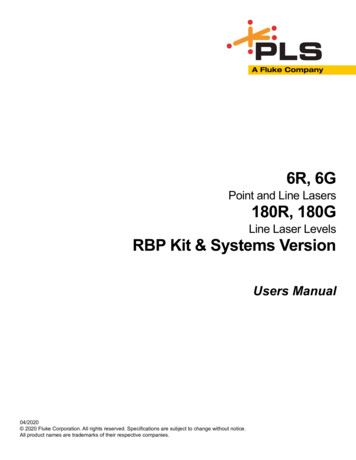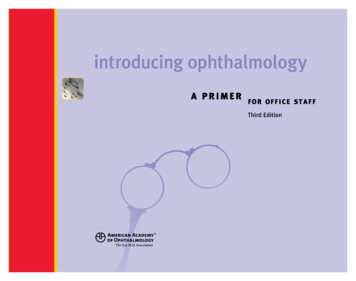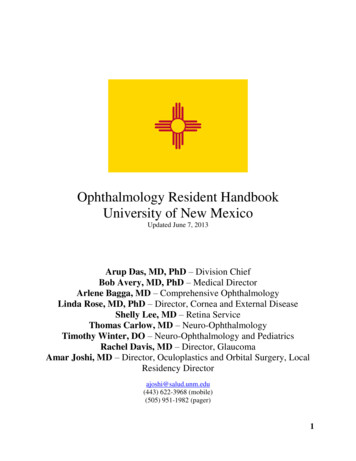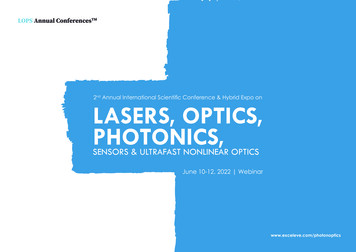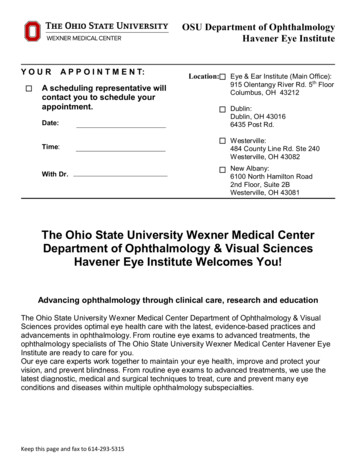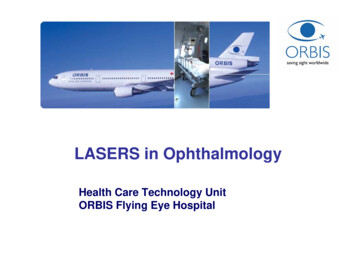
Transcription
LASERS in OphthalmologyHealth Care Technology UnitORBIS Flying Eye Hospital
Contents LASER history Wave theory Overview of LASER Application of LASERs in Ophthalmology LASER Safety
LASER history 1917 - A. Einstein: Laser possible. 1958 - C.H. Townes, A.L. Schawlow: Theoretical basis forlasers. 1960 - T. Maiman: Built first laser. 1963 - C. Zweng: First medical laser trial (retinalcoagulation). 1965 - W.Z. Yarn: First clinical laser surgery.
Light is electromagnetic radiationReproduced from Basic Clinical Science Course,Foundation of the American Academy ofOphthalmology. 2003 - 2004.
“Let there be light.”And the 4 Maxwell’s equationswhere written.“FIAT LUX”
What is LASER? LASER is an acronym for:L – LightA – amplification byS – stimulatedE – emission ofR – radiation
Interference and coherenceReproduced from Basic Clinical Science Course, Foundation ofthe American Academy of Ophthalmology. 2003 - 2004.
Interference and coherenceReproduced from Basic Clinical Science Course, Foundation ofthe American Academy of Ophthalmology. 2003 - 2004.
Interference and coherenceReproduced from Basic Clinical Science Course, Foundation ofthe American Academy of Ophthalmology. 2003 - 2004.
LASER Characteristics MonochromaticORDINARY LIGHT– One colorchromatic CoherentLASER– In-phaseincoherent Collimated– Light waves aligned(less than 0.1 degree of divergence)non-collimated
How is LASER generated? Quantum mechanics: Planck’s equationE n.h.ν n.h.c /λWhere:E : energy leveln : an integer (1, 2, 3, )h : Planck’s constant (6.64x10-34 Js)c : speed of light in vacuum (3x108 m/s)λ : wavelength of the emitted photon (m)ν : frequency of the emitted photon (Hz)
LASER theory Quantum Mechanics: Electrons must be excited toemit light.– Absorption vs. stimulated emissionEnergyexcited levelupper laser levelexcitationby electronor photonlaser transition(emission of photon)lower laser levelground state
Laser theory Stimulated EmissionReproduced from Basic Clinical Science Course, Foundation ofthe American Academy of Ophthalmology. 2003 - 2004.
Stimulated emission leads to achain reaction and laser emissionIf a medium has many excited molecules, one photon can becomemany.Excited mediumThis is the essence of the laser. The factor by which an input beam isamplified by a medium is called the gain and is represented by G.
ElectromagneticenergyReproduced from Basic ClinicalScience Course, Foundation of theAmerican Academy ofOphthalmology. 2003 - 2004.
Wavelengths ofLaser systemsReproduced from Basic Clinical Science Course, Foundation ofthe American Academy of Ophthalmology. 2003 - 2004.
LASER properties Wavelength:– Ultraviolet– Visible– Infrared Power Density:– Milliwatts to Kilowatts Duration of Pulse:– Nanoseconds to Continuous
LASER properties Beam Divergence:– Less than 0.1 degree Coherence:– Millimeters to meters Efficiency, Power Requirements:– 0.01% to 20%
Basic Laser Components Laser Tube (Laser medium Resonatingelement or mirror) Pump or excitation source Power supply Cooling unit (water, air)laser tubepumping energy source(light, electricity)cooling unitpowersupplypower efficiency: 0.01-20%Note: Energy efficiency: Argon 0.01% - Excimer 2%
Basic Laser Components Laser tube and pumpReproduced from Basic Clinical Science Course, Foundation ofthe American Academy of Ophthalmology. 2003 - 2004.
Laser medium and pump Energy (electrical, optical, or chemical) from an external source - the LASERPUMP - interacts with a substance within the optical cavity - LASER MEDIUM - ofa laser to cause energy emission. The substance can be a crystalline solid, a gas, a liquid containing a dissolvedorganic dye, or a semiconductor. When these electrons return to their originalstate, they emit photons with identical wavelengths characteristic of the particularsubstance. Mirrors at either end of the laser tube selectively reflect photons traveling parallelto the tube axis, which strike other atoms and cause the spontaneous emission ofmore photons of identical wavelength. Photons moving in other directions areabsorbed or reflected by the sides of the tube. Eventually, the remaining photons pass through the partially reflective mirror atone end of the tube to the laser delivery system in a coherent beam (one in whichall photons are in phase and moving in the same direction) of extremely highirradiance (power density measured in watts/cm2).
Cooling unit Ophthalmic lasers are typically equipped with a water or air cooling systemto prevent heat damage to the laser medium and pump. In most units, the cooling system is self-contained; others require water anddrain connections.
Surgical Laser Terminology ABLATION — Removal of tissue using laser energy, usually by progressiveVAPORIZATION of the tissue cells. ACTIVE MEDIUM —The core material of a laser that emits a specific wavelengthof light; used to designate the laser type. ARGON LASER — Emits a green wavelength of 514 nm and a blue wavelengthof 488 nm that are readily absorbed by pigmented tissue. AVERAGE POWER — The energy per pulse times the pulse rate. COAGULATION (COAG) — The application of laser energy at a density sufficientto cause thermal DENATURATION of protein without significant loss of tissuemass. Often used to achieve HEMOSTASIS or tissue NECROSIS. CONTACT-TIP METHOD — Nd:YAG LASER surgery conducted with a shapedtip that converts some laser energy to heat, causing a tissue effect only when thetip is in contact with the tissue. CO2 LASER — Carbon dioxide laser. Emits a mid-infrared beam of 10,600 nmthat is absorbed by water.
Surgical Laser Terminology CUTTING — The application of laser energy at a density sufficient to incise or dividetissue, ideally without creating significant thermal tissue damage on either side of thecut. DENATURATION — The disruption of organic molecules (e.g., proteins, collagen) byapplication of energy (e.g., laser light, heat). Raising tissue temperature above 65 Cwill cause denaturation. ENERGY VERSUS POWER — Both express the laser emission’s capacity to causedamage to or achieve a therapeutic effect in tissue. Energy, expressed in joules (J),causes the temperature to rise when applied to a volume of cells; the faster theenergy is delivered, the higher the power, and the faster the temperature rises.Power, expressed in watts (W), is the rate of energy emitted (i.e., J/sec). FIBEROPTIC DELIVERY SYSTEM — A mechanism used to convey laser energy byinternal reflection in a flexible, small-diameter fiber (usually silica) from the laseraperture to a treatment site. FREE-BEAM METHOD — Laser surgery conducted with the laser aperture either ashort distance away from or just touching the target tissue. HEMOSTASIS — The stoppage of blood flow from severed vessels.
Energy ConceptsWATTS – (Power) Rate of Energy Delivery,but doesn’t say how much energy (Dose).JOULES – (Dose) Amount of EnergyDelivered, but doesn’t say how fast (Rate)Joules Watts x Time, i.e.;1 Joule 1000 watts x .001 seconds
Energy ConceptsPOWER DENSITY: Spot Size & PowerWatts per Square Centimeter (W/cm2)Concentration of the Power within the spot size.Analogous to a magnifying glass and the sun.Small spots burn (or ablate) because they aremore intense. Large spots don’t burn as quicklybecause they are less intense. Spot size willchange the power density faster than a changein power.
Energy ConceptsENERGY DENSITY: Spot Size & DoseJoules per Square Centimeter (J/cm2)Concentration of the total “Dose” of lightwithin the spot size. This considers boththe Power Density and length of time.
Different Types of Lasers LASERS are referred to by the substance theyuse (e.g., argon, krypton); each type of laserproduces light, either a characteristicwavelength or a set of discrete wavelengths:– Gas Laser– Insulating Crystal Laser– Solid-state PN Junction Laser– Excimer Laser
Gas LASER Types - Argon, Krypton, HeNe, Excimerrear mirrorlaser rodgas reservoircathodeoutput mirroranode- high voltagepower supply
Gas Laser Laser materials: CO2, He-Ne, Argon, Krypton Pump: electrical field (electrical pump) Laser wavelength:––––10600 nm for CO2633 nm for He-Ne488 and 515 nm for Argon568 nm for Krypton
Gas LASER specificationsArgon:expensive, high powerexcitation: first 10 - 70 A, then 90 - 400 Vemission: 488, 514 nm, - 20 W, continuouscooling: air ( a few Watts), water (higher)lifetime: 1,000 - 10,000 hrs (factory refill)cost: US 1,000s - 10,000sExcimer:expensive, very high poweremission: UV ( 200 nm), 100 Wpulsed ( 100 ns, 10 - 1000 Hz)lifetime: 100 - 1000 shots (user refill)cost: US 35,000 - 50,000HeNe:inexpensive, low powerexcitation: first 10 mA, then 2000 Vemission: 633 nm, 0.1 - 10 mW, continuouslifetime: 10,000 hrscost: US 20 - 100
Solid state LASER Nd: YAG (neodymium in yttrium-aluminum-garnet)rear mirrorlaser crystaloutput mirrorarc or flash lamphigh voltagepower supply The photons emitted from the crystal when it is excited by light energyfrom the flash lamp are transmitted through the partially reflecting mirrorto the delivery system.
Insulation Solid Laser Laser materials: ruby (Al2O3), neodymium (Nd3 ) inyttrium-aluminum-garnet (YAG) Pumps: Xenon flash tube, Krypton arc lamp or tungsteniodine lamp (optical pump) Laser wavelength:– 693 nm for ruby– 1060 nm for Nd: YAG
Semiconductor LASER Diode Laserelectron donorjunctionpowersupply10 μμelectron acceptor 0.5 mm
Solid-state PN Junction Laser(Diode Laser) Laser materials: semiconductor PN junction Pump: electrical field (electrical pump) Laser wavelength:– 760-905 nm for AlGaAs– 1200-1550 nm for InGaAsP
Excimer Laser Laser materials: Rare gases ( Argon, Krypton orXenon) combined with chlorine, fluorine, iodineor bromine. Pump: electrical field (electrical pump) Laser wavelength:
New technology Frequency doubled YAG lasers– Also known as the KTP/532 LASER. Emits a greenwavelength of 532 nm that is readily absorbed bypigmented tissue. Frequency doubled diode lasers– Pure green light Dual fibre lasers– Both infrared and visible Uses a frequency doubling crystal– Best crystals are made in China
LASER energy absorption by water Wavelengths which are readilyabsorbed by water (e.g., CO2) areable to cut precisely (by vaporizingcellular water) without causingsignificant thermal injury to adjacenttissue; However, this also precludes theiruse in liquid environments becausethe energy is absorbed before itreaches the target tissue.Reproduced from Health Devices, ECRI. March 1995—Vol. 24, No. 3
Tissue effects Laser energy typically produces three zones of damage whenapplied to tissue:(1) a crater from which vaporized tissue is ejected;(2) a zone of NECROSIS caused by “boiling” tissue;(3) a zone of coagulation caused by thermal DENATURATION ofcollagen. Laser wavelengths produce depths of damage ranging from 50 μmfor CO2 to 4,000 μm for Nd:YAG energy using the FREE-BEAMMETHOD. The depth of tissue effects for electrosurgery, by contrast, can rangefrom 1,000 to 5,000 μm.
Vaporization versus CoagulationReproduced from Health Devices, ECRI. March 1995—Vol. 24, No. 3
How do Lasers affectthe tissue?Photo effects on mammal tissues: Photochemical damage:– Light of high intrinsic energy breaks the chemical bonds in amolecule and changes its conformation and causes dysfunction. Photothermal damage:– Light causes a rise in temperature within the tissue by energyabsorption. The hydrogen bonds in molecules are relativelyweak and readily destroyed by heating. Photodisruption damage:– Lights of short duration and high energy cause tissue to beionized (plasma formed), which literally tears molecules apart.
Photo Effects on MammalTissue Versus Time
Photo Effects on MammalTissue Versus Wavelength
Laser Effects onMammal Tissue
Example 1 Burning on mammal cornea
Example 2 Cutting on mammal cornea
Example 3 Cutting on mammal cornea
Lasers Application inOphthalmology Photocoagulation Photodisruption Photorefraction
Photocoagulation The photocoagulation effects on eyes depend on the properties ofboth laser and target (tissue).Common photocoagulation Lasers: Note: Nd:YAG laser for photocoagulation is of continuous wave.
Photocoagulation Extinction coefficient versus wavelength for hemoglobinHb
Photodisruption Short-pulsed YAG Laser Wavelength: 1064 nm With He-Ne laser as aiming beam
Delivery Systems Most ophthalmic laser systems consist of a laser module— a laser medium, laser pump, and cooling system thatis typically coupled to a slit-lamp biomicroscope by aflexible fiberoptic cable. Other laser-energy delivery systems include indirectophthalmoscopes, intraocular probes, and interfaces foroperating microscopes. The ophthalmologist views the structures within thepatient’s eye and aims and focuses the laser through theoptics of the slit lamp; when the laser is fired, the energyis delivered through these optics or through coaxialoptics.
Examples of Laser Devices:Diode Laser with Slit Lamp
Diode Laser with Endoprobe
Diode Laser with IndirectOphthalmoscope
LASER SafetyReproduced from Health Devices, ECRI. April 1993 Vol. 22 No. 4
LASER SafetyReproduced from Health Devices, ECRI. April 1993 Vol. 22 No. 4
LASER SAFETYWarning signLight signalDoor contactLASERAccessoriesProtection curtainVentilationand air filtering
Laser Safety Laser ClassificationsANSI (American National Standard Institute) Class I: Very low power, safe to view. Class II: Low power, safe to see for short time. Class III: Medium power, not safe for brief viewing, butno diffuse reflection hazard. Class IV: High power, not safe for brief viewing;reflection hazard.
Laser Safety Safety Measures Safety goggles: Correct optical density forlaser wavelength Safety signs Training Proper maintenance
Laser Safety Safety GogglesReproduced from Health Devices, ECRI. April 1993 Vol. 22 No. 4
DANGERLASER SURGERY IN PROCESS - EYE PROTECTION REQUIREDARGON LASER (800 mW for 1 Seconds maximum)Class IV
DANGERLASER SURGERY IN PROCESS - EYE PROTECTION REQUIREDNd:YAG LASER (10mJ of Energy for 3nanosecond maximum)Class IV
DANGERLASER SURGERY IN PROCESS - EYE PROTECTION REQUIREDARGON LASER (2.5 Watt for 5 Seconds maximum)Class IV
DANGERLASER SURGERY IN PROCESS - EYE PROTECTION REQUIREDDIODE LASER (2 Watt for 9 Seconds maximum)Class IV
LASER REPAIR IN PROGRESSDo Not Enter Unless EmergencyEYE PROTECTION REQUIRED
Laser safety summary The power output of some ophthalmic lasers places them in the highest categoryof risk (American National Standards Institute [ANSI] Class IV); stringent safetyprecautions are necessary to protect staff, patients, and service personnel. Protective shutters built into the equipment, filters incorporated into the slit-lampbiomicroscope, and divergence of the beam at the exit optics help reduce the riskof injury to clinicians during photocoagulation and/or photodisruption procedurescarried out through a biomicroscope. Accessory lenses placed on the patient’s eye during treatment should have anantireflective coating (ARC) because reflected laser light may exceedoccupational exposure limits for momentary viewing if bystanders are within thelaser’s nominal hazard zone (the area in which direct, reflected, or scatteredradiation exceeds safe exposure levels). When a handpiece is used in place of biomicroscopy, precautions must be takento minimize the chance of specular reflection from instruments, which could injureobservers’ eyes. Protective goggles should be used, and warning signs listing thelaser’s type and class should be posted at all entrances to the laser suite.
Maintenance of Laser DevicesTypical problems *:Symptom:Possible cause:no laser outputpower supplyfiber opticscooling systemburn point is offaiming beam is not aligned with laser beamincorrect output power output power need calibrationfiber optics is partially broken* manufacturer authorized maintenance is recommended
Power Calibrationof Laser DevicesTools required: laser power meter; service manual;Setup powerBasic principle: select testing point; compare the setup power with meter reading; adjust the output level until it meets the reading on the laser meter.Measured power
Acknowledgements ALCON Laboratories
Surgical Laser Terminology ABLATION — Removal of tissue using laser energy, usually by progressive VAPORIZATION of the tissue cells. ACTIVE MEDIUM —The core material of a laser that emits a specific wavelength of light; used to designate the laser type. ARGON LASER — Emits a green wavelength of 514 nm and a blue wavelength

